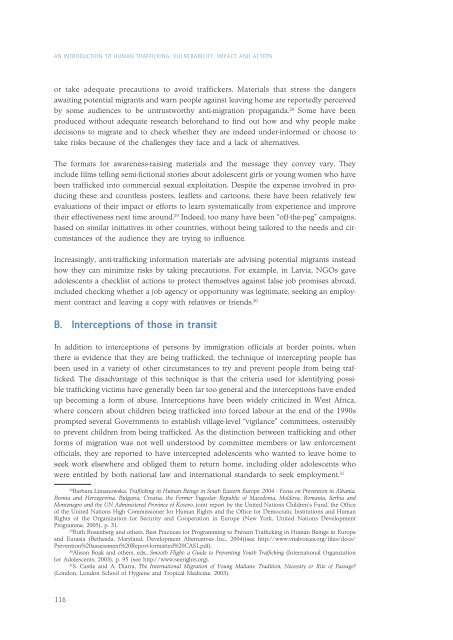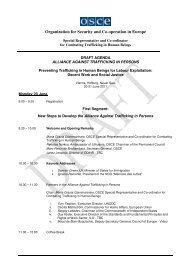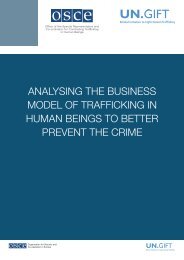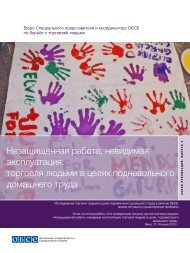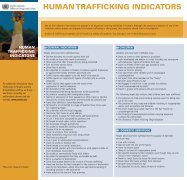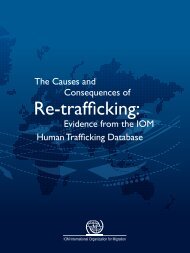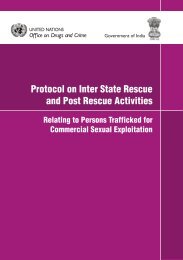An Introduction to Human Trafficking - United Nations Office on ...
An Introduction to Human Trafficking - United Nations Office on ...
An Introduction to Human Trafficking - United Nations Office on ...
Create successful ePaper yourself
Turn your PDF publications into a flip-book with our unique Google optimized e-Paper software.
AN INTRODUCTION TO HUMAN TRAFFICKING: VULNERABILITY, IMPACT AND ACTION<br />
or take adequate precauti<strong>on</strong>s <str<strong>on</strong>g>to</str<strong>on</strong>g> avoid traffickers. Materials that stress the dangers<br />
awaiting potential migrants and warn people against leaving home are reportedly perceived<br />
by some audiences <str<strong>on</strong>g>to</str<strong>on</strong>g> be untrustworthy anti-migrati<strong>on</strong> propaganda. 28 Some have been<br />
produced without adequate research beforehand <str<strong>on</strong>g>to</str<strong>on</strong>g> find out how and why people make<br />
decisi<strong>on</strong>s <str<strong>on</strong>g>to</str<strong>on</strong>g> migrate and <str<strong>on</strong>g>to</str<strong>on</strong>g> check whether they are indeed under-informed or choose <str<strong>on</strong>g>to</str<strong>on</strong>g><br />
take risks because of the challenges they face and a lack of alternatives.<br />
The formats for awareness-raising materials and the message they c<strong>on</strong>vey vary. They<br />
include films telling semi-ficti<strong>on</strong>al s<str<strong>on</strong>g>to</str<strong>on</strong>g>ries about adolescent girls or young women who have<br />
been trafficked in<str<strong>on</strong>g>to</str<strong>on</strong>g> commercial sexual exploitati<strong>on</strong>. Despite the expense involved in producing<br />
these and countless posters, leaflets and car<str<strong>on</strong>g>to</str<strong>on</strong>g><strong>on</strong>s, there have been relatively few<br />
evaluati<strong>on</strong>s of their impact or efforts <str<strong>on</strong>g>to</str<strong>on</strong>g> learn systematically from experience and improve<br />
their effectiveness next time around. 29 Indeed, <str<strong>on</strong>g>to</str<strong>on</strong>g>o many have been “off-the-peg” campaigns,<br />
based <strong>on</strong> similar initiatives in other countries, without being tailored <str<strong>on</strong>g>to</str<strong>on</strong>g> the needs and circumstances<br />
of the audience they are trying <str<strong>on</strong>g>to</str<strong>on</strong>g> influence.<br />
Increasingly, anti-trafficking informati<strong>on</strong> materials are advising potential migrants instead<br />
how they can minimize risks by taking precauti<strong>on</strong>s. For example, in Latvia, NGOs gave<br />
adolescents a checklist of acti<strong>on</strong>s <str<strong>on</strong>g>to</str<strong>on</strong>g> protect themselves against false job promises abroad,<br />
included checking whether a job agency or opportunity was legitimate, seeking an employment<br />
c<strong>on</strong>tract and leaving a copy with relatives or friends. 30<br />
B.—Intercepti<strong>on</strong>s of those in transit<br />
In additi<strong>on</strong> <str<strong>on</strong>g>to</str<strong>on</strong>g> intercepti<strong>on</strong>s of pers<strong>on</strong>s by immigrati<strong>on</strong> officials at border points, when<br />
there is evidence that they are being trafficked, the technique of intercepting people has<br />
been used in a variety of other circumstances <str<strong>on</strong>g>to</str<strong>on</strong>g> try and prevent people from being trafficked.<br />
The disadvantage of this technique is that the criteria used for identifying possible<br />
trafficking victims have generally been far <str<strong>on</strong>g>to</str<strong>on</strong>g>o general and the intercepti<strong>on</strong>s have ended<br />
up becoming a form of abuse. Intercepti<strong>on</strong>s have been widely criticized in West Africa,<br />
where c<strong>on</strong>cern about children being trafficked in<str<strong>on</strong>g>to</str<strong>on</strong>g> forced labour at the end of the 1990s<br />
prompted several Governments <str<strong>on</strong>g>to</str<strong>on</strong>g> establish village-level “vigilance” committees, ostensibly<br />
<str<strong>on</strong>g>to</str<strong>on</strong>g> prevent children from being trafficked. As the distincti<strong>on</strong> between trafficking and other<br />
forms of migrati<strong>on</strong> was not well unders<str<strong>on</strong>g>to</str<strong>on</strong>g>od by committee members or law enforcement<br />
officials, they are reported <str<strong>on</strong>g>to</str<strong>on</strong>g> have intercepted adolescents who wanted <str<strong>on</strong>g>to</str<strong>on</strong>g> leave home <str<strong>on</strong>g>to</str<strong>on</strong>g><br />
seek work elsewhere and obliged them <str<strong>on</strong>g>to</str<strong>on</strong>g> return home, including older adolescents who<br />
were entitled by both nati<strong>on</strong>al law and internati<strong>on</strong>al standards <str<strong>on</strong>g>to</str<strong>on</strong>g> seek employment. 31<br />
28<br />
Barbara Limanowska, <str<strong>on</strong>g>Trafficking</str<strong>on</strong>g> in <str<strong>on</strong>g>Human</str<strong>on</strong>g> Beings in South Eastern Europe: 2004 - Focus <strong>on</strong> Preventi<strong>on</strong> in Albania,<br />
Bosnia and Herzegovina, Bulgaria, Croatia, the Former Yugoslav Republic of Maced<strong>on</strong>ia, Moldova, Romania, Serbia and<br />
M<strong>on</strong>tenegro and the UN Administered Province of Kosovo, joint report by the <str<strong>on</strong>g>United</str<strong>on</strong>g> <str<strong>on</strong>g>Nati<strong>on</strong>s</str<strong>on</strong>g> Children’s Fund, the <str<strong>on</strong>g>Office</str<strong>on</strong>g><br />
of the <str<strong>on</strong>g>United</str<strong>on</strong>g> <str<strong>on</strong>g>Nati<strong>on</strong>s</str<strong>on</strong>g> High Commissi<strong>on</strong>er for <str<strong>on</strong>g>Human</str<strong>on</strong>g> Rights and the <str<strong>on</strong>g>Office</str<strong>on</strong>g> for Democratic Instituti<strong>on</strong>s and <str<strong>on</strong>g>Human</str<strong>on</strong>g><br />
Rights of the Organizati<strong>on</strong> for Security and Cooperati<strong>on</strong> in Europe (New York, <str<strong>on</strong>g>United</str<strong>on</strong>g> <str<strong>on</strong>g>Nati<strong>on</strong>s</str<strong>on</strong>g> Development<br />
Programme, 2005), p. 31.<br />
29<br />
Ruth Rosenberg and others, Best Practices for Programming <str<strong>on</strong>g>to</str<strong>on</strong>g> Prevent <str<strong>on</strong>g>Trafficking</str<strong>on</strong>g> in <str<strong>on</strong>g>Human</str<strong>on</strong>g> Beings in Europe<br />
and Eurasia (Bethesda, Maryland, Development Alternatives Inc., 2004)(see http://www.vitalvoices.org/files/docs/<br />
Preventi<strong>on</strong>%20assessment%20Report-formatted%20CAS1.pdf).<br />
30<br />
Alis<strong>on</strong> Boak and others, eds., Smooth Flight: a Guide <str<strong>on</strong>g>to</str<strong>on</strong>g> Preventing Youth <str<strong>on</strong>g>Trafficking</str<strong>on</strong>g> (Internati<strong>on</strong>al Organizati<strong>on</strong><br />
for Adolescents, 2003), p. 95 (see http://www.seerights.org).<br />
31<br />
S. Castle and A. Diarra, The Internati<strong>on</strong>al Migrati<strong>on</strong> of Young Malians: Traditi<strong>on</strong>, Necessity or Rite of Passage?<br />
(L<strong>on</strong>d<strong>on</strong>, L<strong>on</strong>d<strong>on</strong> School of Hygiene and Tropical Medicine, 2003).<br />
116


